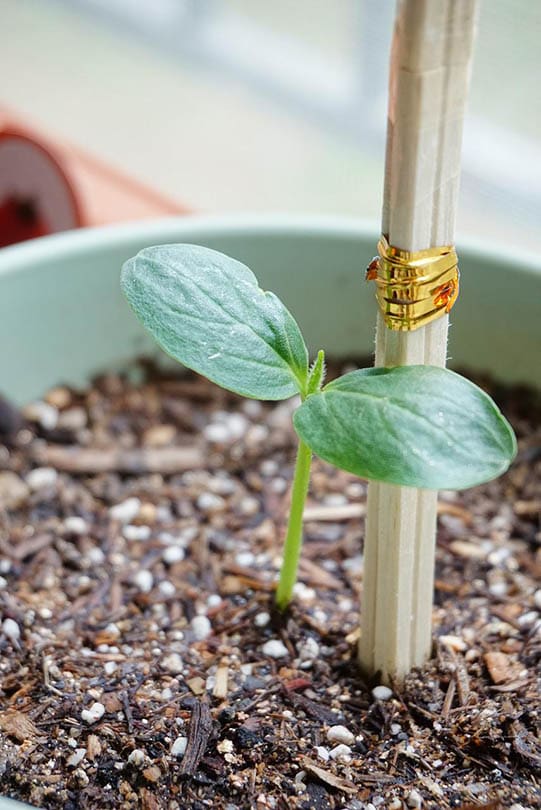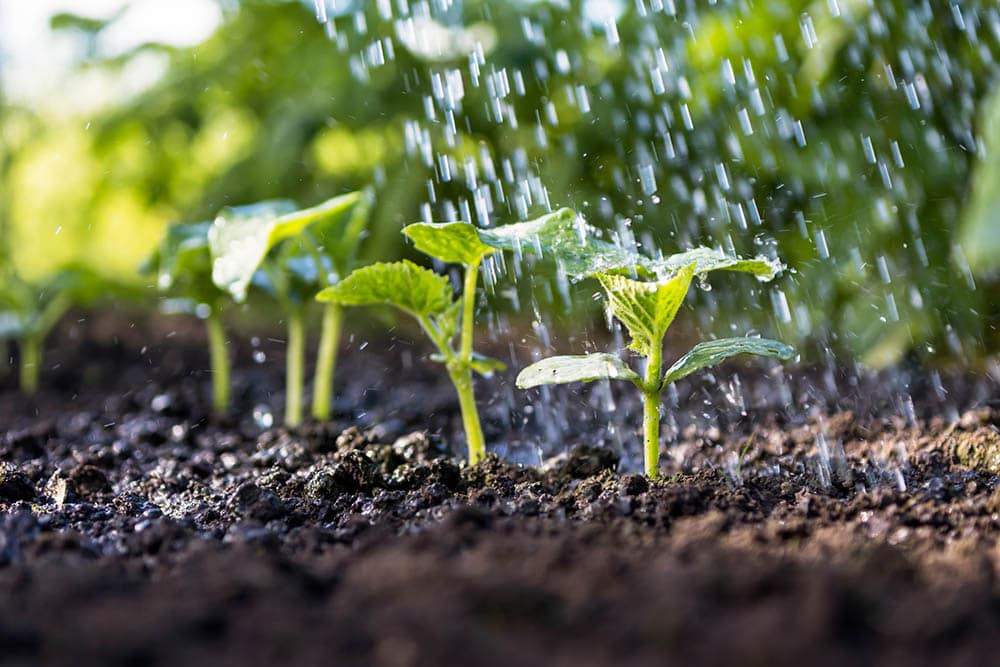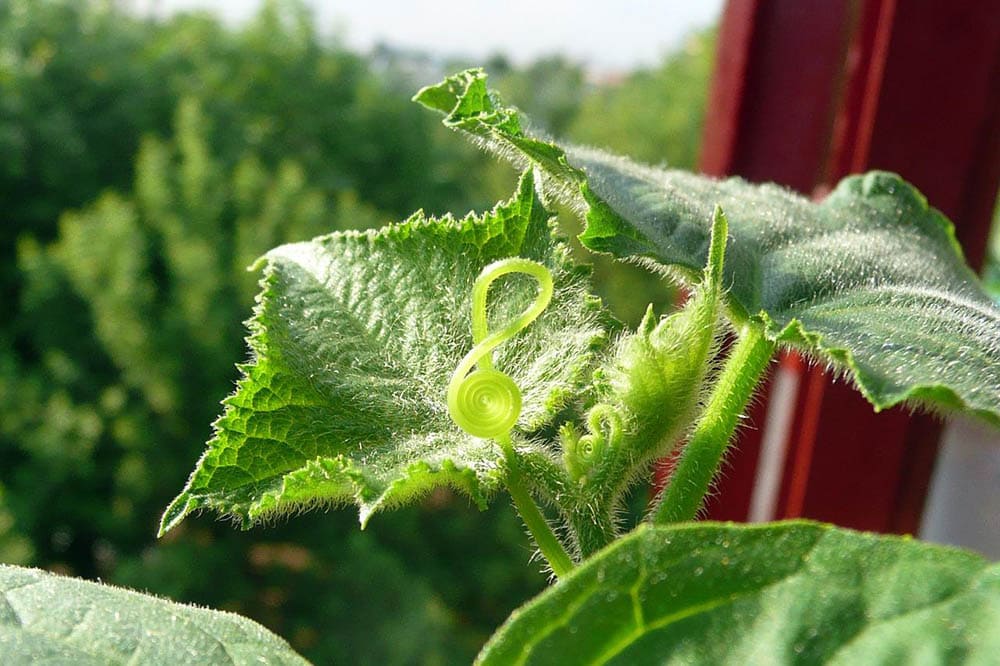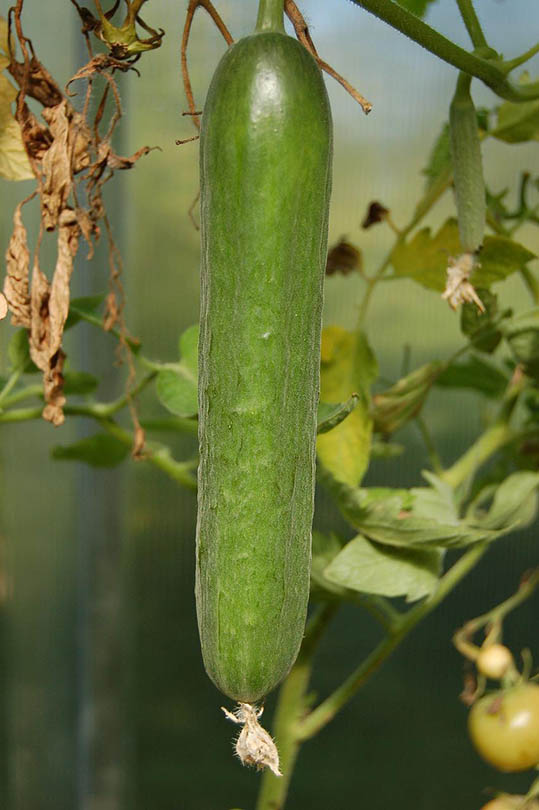How to Grow Cucumbers Indoors: Care Tips & Step by Step Guide
-

- Last updated:

Indoor gardening provides exciting opportunities to grow anything you want like plants, flowers, herbs, and vegetables. Among the best vegetables you can grow indoors are healthy and nutritious cucumbers.
With just the right containers and soil, you can grow them from seeds using direct sowing. Alternatively, you can buy or germinate some seedlings. When they attain the right size, all you have to do is plant them in the bigger pots.
Read on to learn all about the care and management of growing cucumbers indoors. In addition, you can learn the best way to harvest and store mature cucumber fruits.

Different Cucumber Varieties to Grow Indoors
Imagine having some lovely cucumbers growing in a container somewhere in your home. You can pluck a fresh cucumber any time and make a salad, but which are the best varieties of cucumbers to grow indoors?
There are two ways you can categorize cucumbers. One kind is better for pickling, and the other is better for slicing.
- Picklebush
- Carolina
- Burpee Pickler
- Supremo
- Fancipak
- Parisian
- Sweet Success
- Funfare
- Marketer
- Sweet Slice
- Salad Bush
- Sugar Crunch
The slicing varieties of cucumbers have a smooth, outer skin and are best eaten fresh. Pickling cucumbers are short and have more spines on the skin. These are best for pickling, though there are a few ideal for slicing as well.

Things You Should Note
When growing cucumbers indoors, there are several things to note. First, you have to pick out the right kind of container and size. Second, know the ideal soil to use for a healthy crop and an ample harvest at the end of the growing season.
Container Selection
Cucumbers are some of the best vegetables that thrive when grown in containers. The bush varieties are a perfect example.
Which container or pot is ideal for growing cucumbers indoors? It’s better to go for a plastic container or a ceramic pot provided it is wide and deep. It should be 8 inches wide and 8 inches deep. This gives the roots ample space to spread as the plant grows taller and wider.
Apart from the size of the container, also consider the drainage. Select a container that has at least 3 drainage holes. This enables the soil to retain moisture but won’t become waterlogged.
Type of Soil
After choosing the right container, it’s time to select the ideal soil. Cucumbers do well in fertile soil with sufficient nutrients to feed the plant. Loam soil would be ideal. Also, you can add compost to the soil to make it richer.
Apart from loam soil, there’s also a potting mix suitable for growing cucumbers indoors. This requires mixing equal parts of the mix with other things to create the best growing medium. In the ratio of 10:10:10, mix potting soil, compost, and perlite/peat moss.
Cucumbers love slightly acidic soil with a pH of 6.0–6.5. This is better achieved by adding compost to the potting mix.
The Step by Step Guide on How to Grow Cucumbers Indoors
Now that you have the right containers and soil type, it is time to start planting your cucumbers. At this stage, decide if you want to start with seeds or seedlings. Seeds are simple to grow, but you need a smaller container to start them.
After the seeds germinate and grow into seedlings, you can transplant them into bigger containers.
Germinating seeds require your utmost attention to get the best seedlings. It’s better to use a growing tray and a seedling mix for cucumber seeds. To get them started, use four parts compost, 2 parts peat moss, 1 part perlite, and 1 part vermiculite.
1. Get the Best Seedlings

Check if the seedlings are the right size to transplant into the growing pots. The right size for seedlings is 3–4 inches tall. As you do so, prepare the soil by adding it to the new containers. Fill each container almost to the top.
If you do not want to use seedlings, you can sow the seeds directly into the soil. Use your finger to dig a hole about 1 inch deep. Throw in a seed and cover it with soil. Each pot can carry 2–3 plants, so repeat the same steps once or twice until you have your desired amount.
2. Planting the Seedlings

Get a small trowel or tablespoon and dig two to three holes in the soil. The holes can be 2 inches deep to fit the seedlings.
Remove the seedlings from the seedling tray or container, ensuring you carry all the soil surrounding the roots and place it in the hole. Cover the seedling base with soil.
3. Watering

Water the cucumber seedlings after you finish planting them. This is the best time to check if the drainage holes are working. Excess water needs to drain from the bottom of the container. After watering the new cucumber plants, pick a bright spot to place the containers.
The 4 Care and Maintenance Tips for Cucumbers
Before you kick off your shoes and relax, remember that growing cucumbers need proper care. Below are some of the requirements to meet if you want to grow the vegetable successfully.
1. Light Intensity

Cucumbers love ample bright light, so those dark corners in your home are better for other plants. Place the cucumber containers in an area where lots of bright light comes in. However, ensure its bright, indirect light that won’t burn the leaves. If there’s not an ample amount of light in your house, consider getting some growing lights.
If these vegetables are in an area with low to medium light, the plant turns yellowish and begins to experience stunted growth.
2. Watering Needs
Some plants love dry conditions with minimal watering, but cucumbers are the total opposite. It’s important to have a watering schedule to maintain enough moisture in the soil.
In spring and summer, daily watering is recommended, but it should not be so wet that it causes root rot. In winter, there’s more moisture retention, so you don’t have to water the plants daily.
3. Fertilizer Requirements
During the growing and fruiting stages, cucumbers need lots of nutrients. Since the plant is growing in a container, start adding compost or fertilizer.
As the water drains, it will tend to wash out nutrients from the soil. Fortunately, there are soluble and slow-release fertilizers you can use to supplement the plant. In addition, top off the compost and watch the plant grow large healthy cucumbers.
4. Pests and Disease Control

Another care tip for cucumbers is controlling pests and diseases.
- Aphids
- Cucumber Beetles
- Thrips
- Spider Mites
- Angular leaf spot
- Bacterial wilt
- Anthracnose
- Powdery mildew
- Downy mildew
- Cucumber mosaic virus
One excellent tip to prevent an insect infestation and diseases from spreading is to avoid overcrowding. Grow two or three plants per pot and keep the pots separate. Several inches between each pot can be helpful in controlling such issues.

Harvesting Mature Cucumbers
The goal of growing cucumbers is to ultimately harvest mature fruits. Cucumbers take time to grow, so you might need to wait up to 70 days before harvesting them. If you harvest the fruit too early, it might not be as sweet as you expect. But also ensure you don’t leave the fruit on the vine for too long. Doing so can cause bitterness, which ruins the whole crop.
To note the right harvest time for cucumbers, keep an eye on the female flowers. About 10 days after the female flowers open, the cucumber fruits are ready for harvesting. At this point, you might end up harvesting cucumbers every 2 days. Pick the fruits in the morning using a sharp and clean gardening tool.
It’s better not to pluck the cucumbers from the vines since this can cause injury. Instead, cut the stem about 6 millimeters from the fruit and place them in a basket that won’t cause skin bruising.
Frequently Asked Questions
Is It Better to Grow Cucumbers Vertically or Horizontally?

It’s possible to have a container garden indoors, but this can limit you when it comes to size. This is why it’s better to grow cucumbers vertically in containers and not horizontally.
Some vertical garden ideas perfect for cucumbers are:
- Arches: This requires creating an arch in your garden room. Then, you start training vines to climb as the plant grows.
- Trellis: Trellises are popular for outdoor gardens, but you can have a smaller one indoors. Find one that’s about 3–4 feet tall and assemble it before planting cucumbers in containers.
- Pergola: This is a stand-alone structure that provides excellent space for vines to grow vertically.
- A-frame: An A-frame structure is as it sounds. Ensure you create a strong one to hold the vines.
- Teepee: This is made using bamboo and resembles a trellis. The cucumber vines won’t touch the ground when you use it.
Staking a Cucumber Vertically
Apart from the vertical garden ideas, you can simply stake the cucumber vines. Find a way to support two stakes on opposite sides of the cucumber containers. After that, you can tie some strings running horizontally from one end to the next.
The staking method works better for bush cucumbers than those that grow on vines. The stakes and string will provide the growing cucumbers with ample support. Since one plant can produce numerous fruits, the support will prevent bending or breaking.
How do you store ripe cucumbers?
Freshness is a top priority when you harvest cucumbers. Proper storage will guarantee you a fresh supply of whole cucumbers for 7 days. But when you cut them, refrigeration keeps them fresh for 3 days max.
Though some cucumbers are ideal for slicing, don’t cut them until you want to eat or cook them. Whole cucumbers last longer in a zip-lock bag in the refrigerator. This is a better place to store them compared to out in the open at room temperature.
How many cucumbers do you get from one plant?

A mature cucumber plant can produce between 10–20 fruits during the growing season. The amount you get when harvesting depends on the cucumber variety.
Note that if there are multiple plants growing in one container, it can limit fruit production. It’s always better to plant two to three plants per container. Also, get the right size pot to prevent overcrowding.
Is it possible to prune cucumbers for more stem and leaf growth?
At some point during the growing season, small cucumber plants will start to flower. Usually, this is too early to bear fruits, so pinch these buds off the plant. Removing the flower buds helps the cucumber plant grow stronger stems and more leaves.
Conclusion
Growing cucumbers indoors can be lots of fun. Within 70 days, you can enjoy juicy cucumbers on salads and pickle the rest. It’s better to pick out the right variety, container, and soil before getting started.
Proper care and maintenance will entail ample bright light, frequent watering, fertilizer or compost application, and pests and disease control. After they mature, harvest the cucumbers at the right moment and store them whole in the refrigerator. Doing so maintains freshness for about a week.
Featured Image Credit: Sweetaholic, Pixabay
Contents


